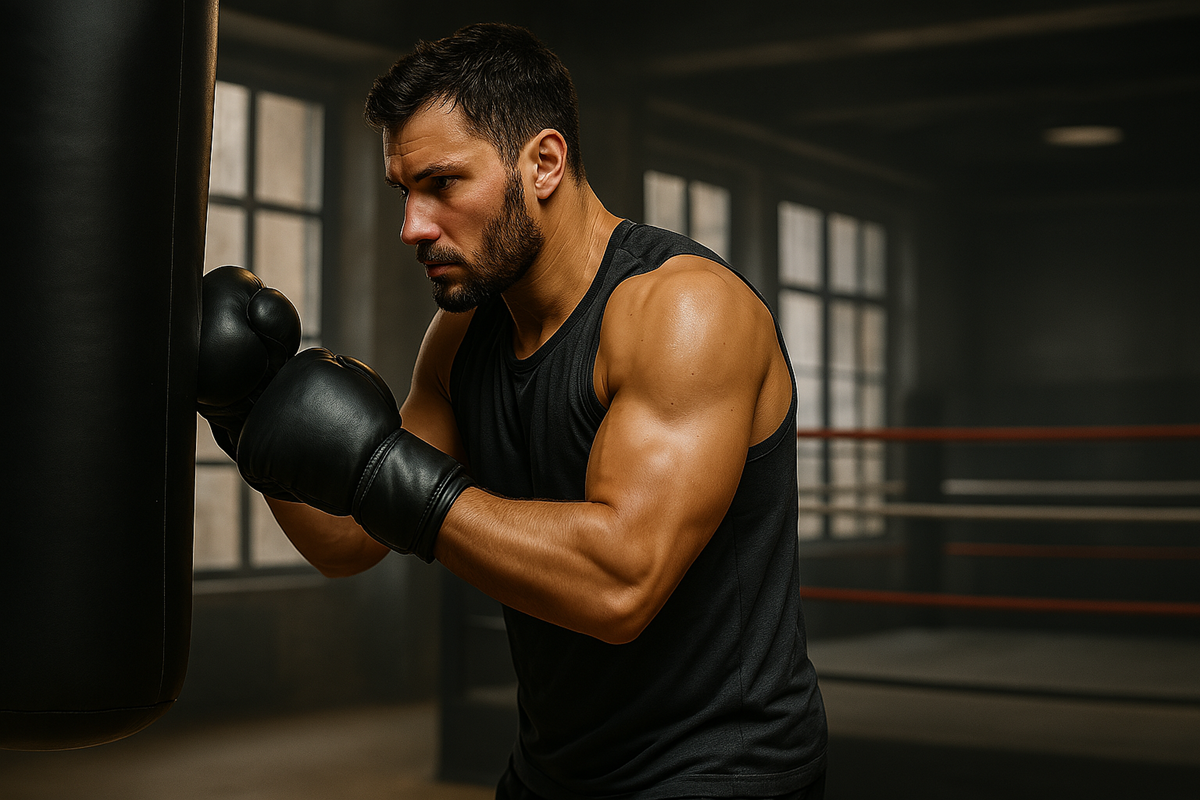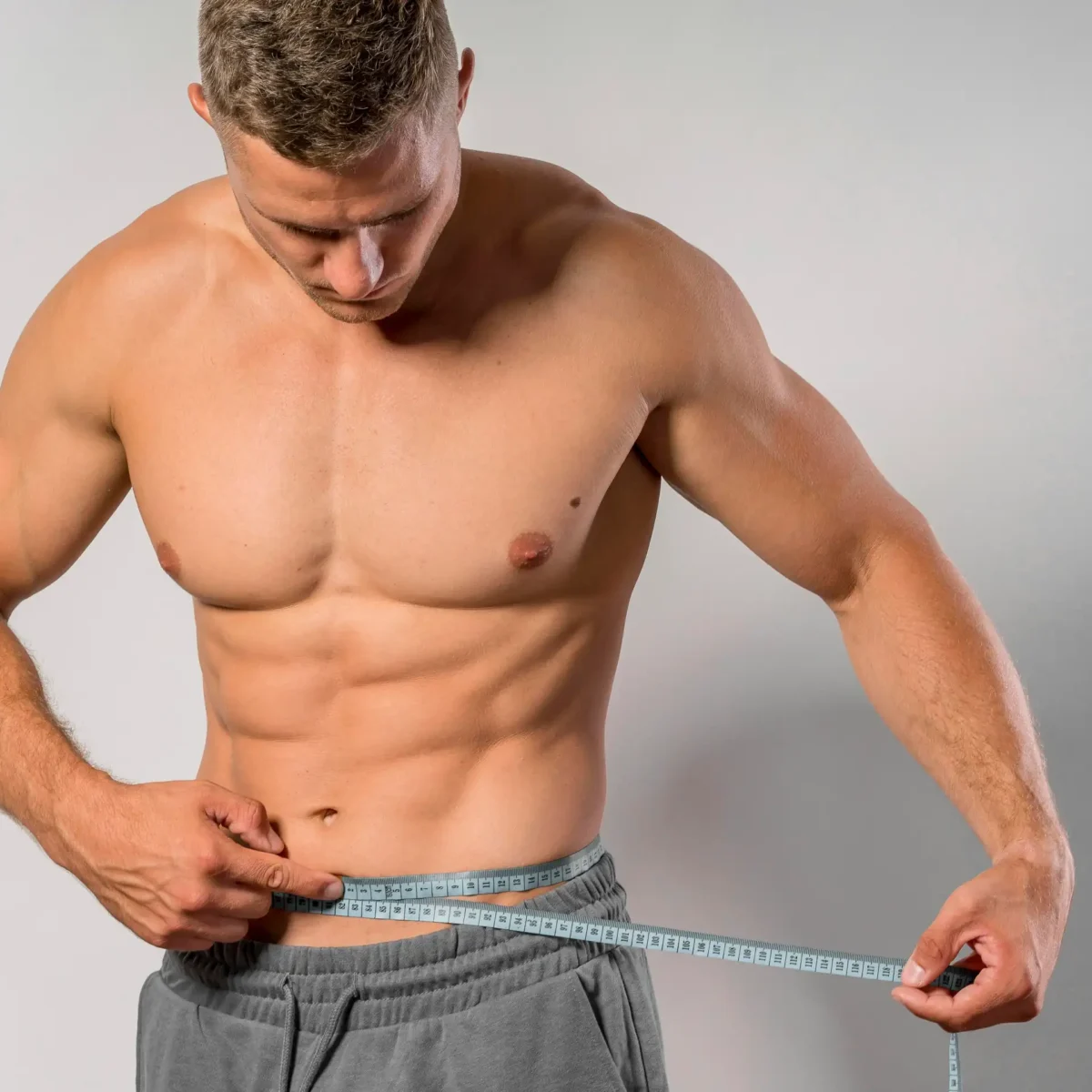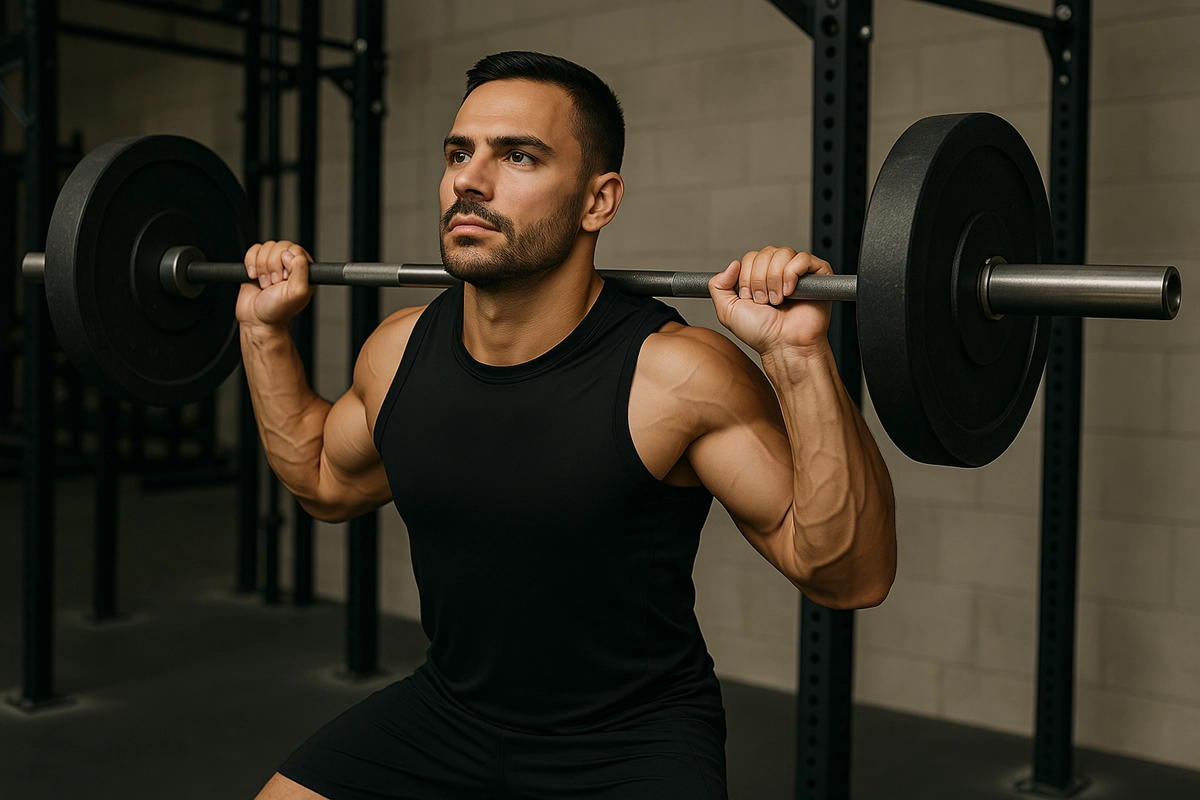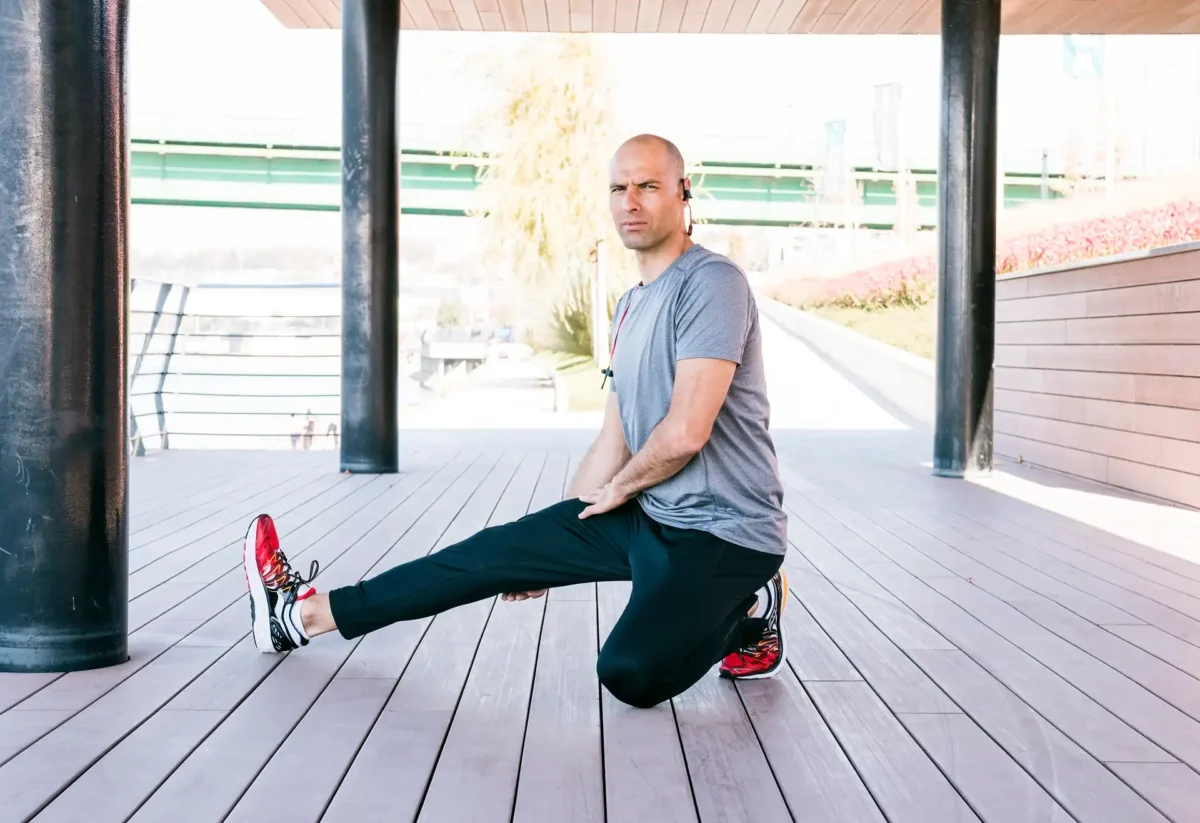While most fighters focus solely on power punches, the true secret to boxing prowess lies in mastering a complete training system that builds both explosive strength and technical finesse.
You’ll discover how Arnold Schwarzenegger’s principle of “shocking the muscles” applies perfectly to boxing workouts, keeping your body guessing and constantly improving.
These five specialised routines will transform your fighting abilities and cardiovascular endurance, taking you from amateur status to advanced pugilist performance.
First, Master the Stance
Three key elements make a proper boxing stance: foot positioning, weight distribution, and guard placement.
To enhance your boxing skills, start by positioning your feet shoulder-width apart on an imaginary line. If you’re right-handed, move your left foot forward until the heel touches the line, while your right foot shifts back until the toe aligns.
For peak punching power, distribute your weight on the balls of your feet with slightly bent knees.
When wearing boxing gloves, position your dominant hand at chin level, with your index finger touching the side. Keep your non-dominant hand at cheek height.
Remember to tuck your elbows against your ribs – this protects your body and maximizes power transfer through your strikes.
3 Basic Boxing Punches
Now that you’ve mastered your basic boxing stance, it’s time to learn the three fundamental punches that’ll form the foundation of your boxing arsenal.
Your jab is a quick straight punch with your lead hand, while the cross is a power punch thrown with your rear hand that rotates through your core and hips.
The hook is a shorter-range punch thrown in a horizontal arc, typically with your lead hand, that can deliver devastating power when executed properly.
1. Jab
The jab stands as boxing’s most essential punch – a quick, straight strike delivered with your lead hand that serves as the foundation for your entire offensive arsenal.
In your boxing stance, you’ll use this nondominant hand punch more than any other, as it’s closest to your opponent.
While not your most powerful punch, the jab’s actual value lies in setting up your combinations and controlling distance during technical training.

To improve your punching ability, study the masterful jabs of legends like Muhammad Ali, Larry Holmes, Ike Quartey, and Gennady Golovkin.
Shadow boxing with emphasis on the jab will help develop proper form and timing.
Remember: your jab is like your opponent’s doorbell – you’ve got to ring it before entering with power shots.
2. Cross
Releasing your cross delivers devastating power through your rear hand, creating one of boxing’s most formidable weapons.
During heavy bag work, you’ll generate maximum force by rotating your torso and pushing through your legs while maintaining a straight punch trajectory.
Your cross requires precise boxing science to execute correctly.
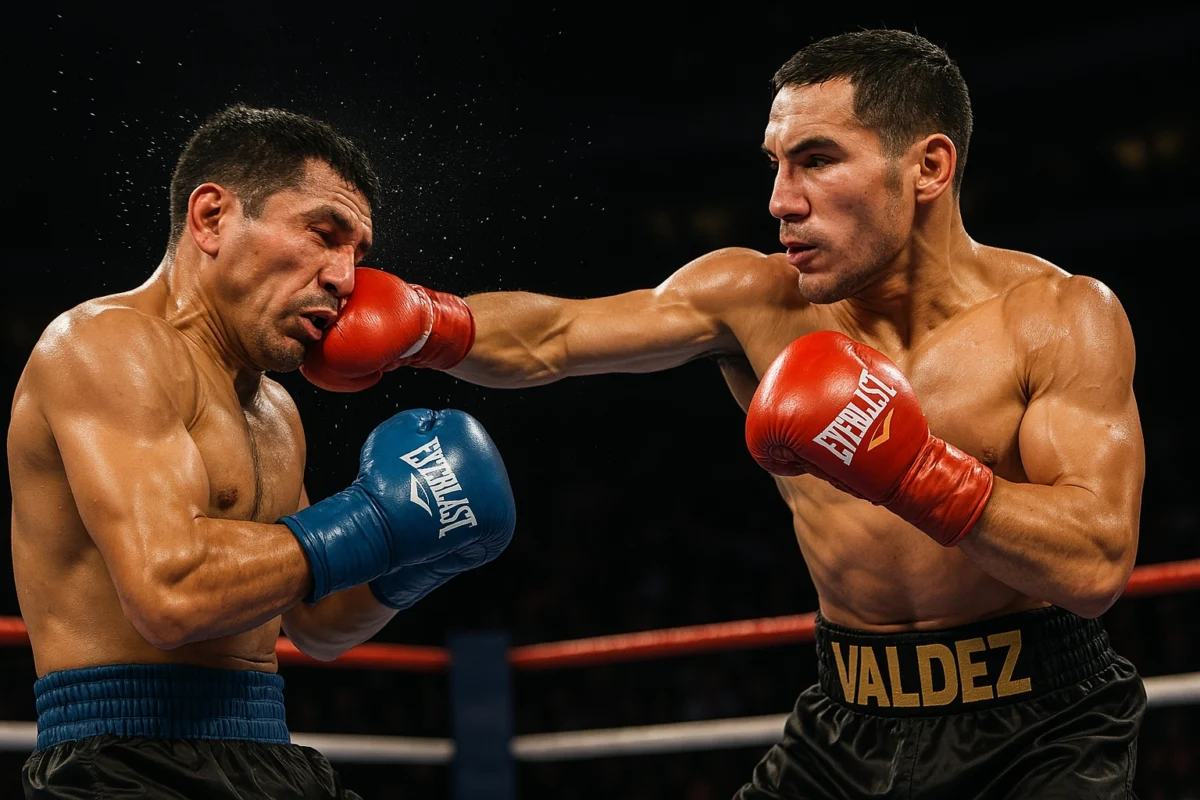
When incorporating it into your training program, remember these key points:
- Throw from your rear hand (furthest from the target)
- Drive power from the legs through the torso
- Keep punching straight and focused
- Use primarily as a counter-punch
- Practice punching a bag to perfect form
Study the technique of boxing greats like Thomas Hearns and Manny Pacquiao to understand proper cross mechanics.
Their powerful crosses demonstrate how this punch, when mastered, becomes your most devastating offensive tool.
3. Hook
While straight punches form the foundation of boxing, mastering a powerful hook transforms your arsenal with devastating side-angle attacks. Unlike linear punch bag work, your hook punch travels from your shoulder before turning inward, powered by your hips and legs. This technique is essential to any serious training regimen and cardio fitness program.
You’ll want to focus primarily on developing your lead hand hook, as it provides better defensive coverage. Keep your movement compact – your elbow shouldn’t extend beyond your shoulder width.
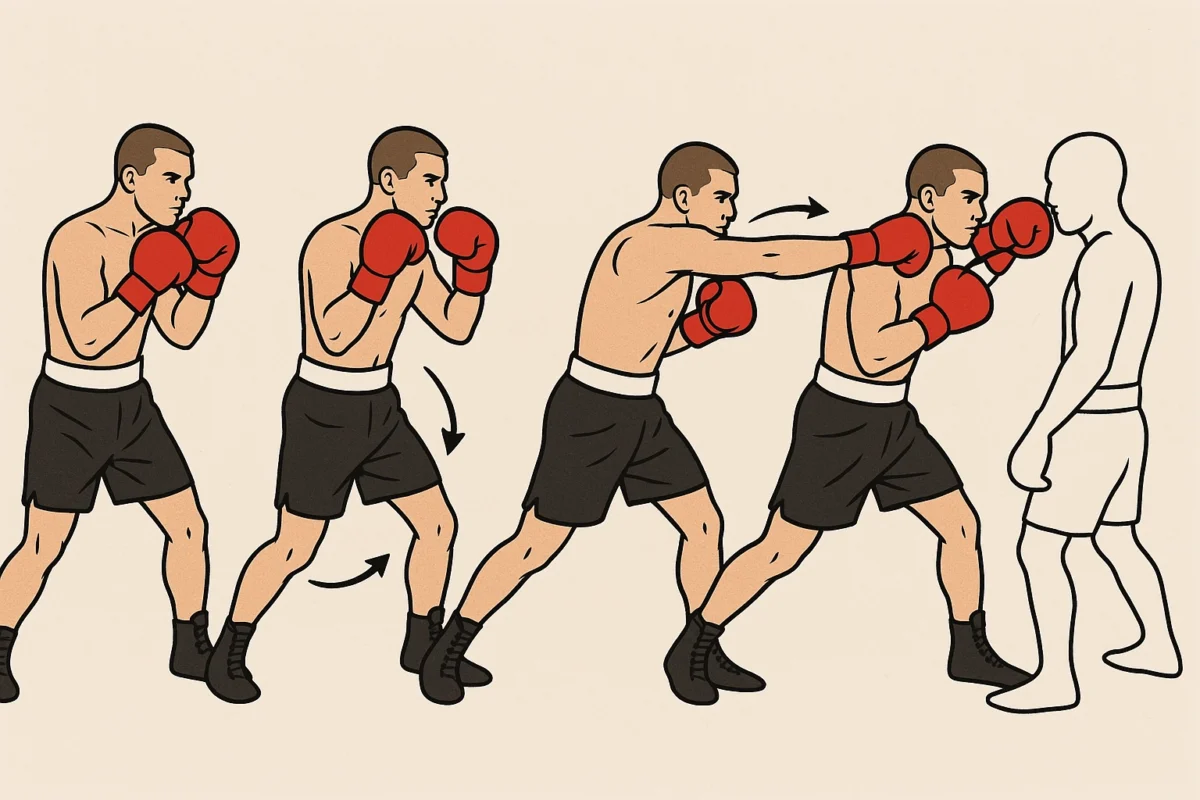
Many boxing champions like Mike Tyson and Joe Frazier built their reputations on devastating hooks. As you practice, remember to return your hand along the same path you threw it, maintaining proper form throughout the motion.
Once you’ve got the individual punches, you need to put them together. Common combinations include:
- Jab-cross
- Jab-cross-hook
- Jab-jab-cross
- Jab-hook-cross
- Cross-hook-cross
- Hook-cross-hook
- Jab-cross-hook-cross
- Jab-cross-jab-cross-hook-hook
Boxing Workout 1
Start your first boxing workout with a dynamic warmup that includes jumping rope, jogging, and mobility exercises to get your muscles firing and blood flowing.
You’ll then move into shadow boxing to practice proper form and footwork before hitting the heavy bag with basic punch combinations like jabs, crosses, and hooks.
End this challenging session with a high-intensity finisher of 3-minute rounds alternating between burpees and mountain climbers to build that championship-level conditioning that Arnold always preached about.
#Warmup
A proper warmup routine gets your body ready for an intense boxing session while preventing injury.
You’ll start your conditioning sessions with 10 minutes of jump rope to elevate your heart rate and improve footwork coordination.
Follow this warmup routine:
- Jump rope: 10 minutes of continuous movement
- Bodyweight exercises (in order):
- 20 squats for lower body activation
- 20 pushups to engage chest and shoulders
- 40 crunches to strengthen your core
This exercise routine primes all major muscle groups you’ll need for boxing.
Don’t skip these fundamental movements – they’re essential for maximizing your performance and reducing injury risk.
When you complete this warmup sequence, you’ll be ready to tackle the main boxing workout with proper form and intensity.
#Shadow Boxing
Once you’ve completed the warmup, shadow boxing serves as your first major boxing workout component, requiring you to move continuously while throwing punches at an imaginary opponent.
This foundational workout routine builds your aerobic fitness while perfecting your technique before moving on to punching bag work.
Execute 5 rounds of the following sequence:
- 3 minutes of basic punch combinations
- Focus on jabs, crosses, and hooks
- Keep proper form throughout each round
- Rest 30 seconds between rounds
Move like you’re facing a real opponent, staying light on your feet while maintaining proper boxing stance.

Even Arnold, who incorporated boxing into his fitness regimen, emphasized that shadow boxing is essential for developing muscle memory and improving coordination before working with a personal trainer or equipment.
#Heavy Bag Workout: Basic Combinations
Moving from shadowboxing to the heavy bag intensifies your boxing workout, letting you release combinations with full power and resistance. The heavy suitcase serves as essential boxing equipment for developing proper form and power while executing your training plan.
You’ll perform this boxer workout in 3-minute rounds with 30-second rest periods between each round. If you’re new to high-intensity training, start with 3 rounds and take 1-minute breaks. As your conditioning improves, progress to the complete 5 rounds with shorter rests.
Remember to maintain a steady pace throughout each round. Unlike focus mitts work, the heavy bag demands consistent energy management.
Even when fatigue sets in, keep making contact with the bag – light touches count. This approach builds the endurance and rhythm essential for real boxing performance.
#Finisher
To complete this intense boxing workout, you’ll tackle a challenging finisher designed to push your muscular endurance to the limit. After your pad work and circuit training, this metabolic conditioning finale will test your resolve.
Complete the following with minimal rest:
- 100 pushups (break into sets if needed)
- 100 squats (maintain proper form)
- 200 situps (pace yourself)
This high-intensity interval training sequence serves as the perfect muscle conditioning closer to your boxing session.
Just like Arnold’s famous “last rep principle,” it’s about pushing through when your body wants to quit. Remember to breathe consistently throughout each exercise, and keep moving even when fatigue sets in.
The goal is to finish strong, proving to yourself that you’ve got what it takes to endure a boxer’s demands.
Boxing Workout 2
You’ll start your second boxing workout with a dynamic warmup focusing on shoulder mobility and hip rotations.
Next, you’ll practice essential footwork drills including pivot steps, lateral movements, and quick direction changes to build agility and ring control.
Finally, you’ll finish strong with three rounds of high-intensity shadowboxing combined with bodyweight exercises that’ll leave you feeling like Arnold after his famous “pump” workouts.
#Warmup
Before diving into the intense boxing drills, this dynamic warmup sequence will fire up your muscles and get your heart pumping.
Start with 50 jumping jacks to elevate your heart rate, then shift into 50 jump lunges to activate your lower body. Keep the intensity high with a one-minute run in place.
Move into 10 pushups to engage your upper body, followed by 10 squats and 10 lunges to build leg strength.
Cap off your warmup with five minutes of shadow boxing, focusing on proper form and footwork.
This high-intensity training sequence combines traditional boxing warmup elements with bodyweight exercises to prepare you for the main workout.
Remember to maintain a steady pace and minimize rest periods between exercises to maximize the cardiovascular benefits and muscle activation.
#Footwork Drills
Now that your muscles are warm and ready, mastering footwork fundamentals will transform your boxing game.
These five training modules will enhance your agility and ring control:
- Side Steps (2 min): Alternate 10 quick steps left and right from your boxing stance, pushing off the opposite foot. Rest 30 seconds.
- Forward/Back Steps (2 min): Execute 10 steps forward and back, maintaining proper foot drive. Rest 30 seconds.
- Box Steps (2 min): Create squares with 6 steps in each direction, switching after four complete patterns. Rest 30 seconds.
- Circle Drill A (2 min): Move around a center point while facing it, perfect for training moving away from an opponent. Rest 30 seconds.
- Circle Drill B (2 min): Face outward while circling, simulating stalking a moving opponent.
#Finisher
Close out this intense boxing session with a 10-minute jump rope cooldown, letting your heart rate gradually descend while maintaining coordination and footwork mastery.
You’ll notice how this finisher combines cardiovascular endurance with the refined footwork patterns you’ve developed during training.
Like all great plyometric boxers, incorporating jump ropes into your training schedule helps maintain that essential mind-muscle connection.
While the speed bag works your upper body coordination, the jump rope targets your lower body timing and rhythm.
Keep your movements fluid and controlled, focusing on:
- Maintaining proper posture
- Landing softly on the balls of your feet
- Keeping your elbows close to your sides
- Breathing steadily throughout
- Gradually reducing your pace
This cooldown guarantees proper recovery while reinforcing the fundamental skills needed for boxing excellence.
Boxing Workout 3
You’ll build explosive power and endurance in this advanced boxing workout that combines classic techniques with high-intensity conditioning.
Starting with dynamic warmups and progressing through rounds of shadow boxing and heavy bag work, you’ll challenge both your technical skills and cardiovascular capacity.
The workout peaks with targeted conditioning drills before finishing with an all-out burst that’ll leave you feeling like Arnold after his famous “pump” workouts at Gold’s Gym.
#Warmup
Before diving into the intense boxing drills ahead, start with a solid 20-minute jog to get your blood flowing and muscles warmed up properly. Proper warming up is essential for preventing injuries and optimizing your performance, just like professional fighters do before boxing tournaments.
Your jogging pace should be moderate enough to break a sweat but still maintain a conversation. This active recovery period prepares your body for the more demanding training phases ahead.
Focus on maintaining proper form while jogging: keep your chest up, shoulders relaxed, and arms swinging naturally at your sides.
This cardio-focused warmup isn’t just about preparing for today’s workout – it’s an investment in your long-term cardiovascular health.
As Arnold always says, “The mind is the limit. As long as the mind can envision something, you can do it.”
#Shadow Boxing
Since shadow boxing forms the foundation of a fighter’s training arsenal, this classic workout consists of 5 intensive 3-minute rounds with 30-second rest periods between each round.
Unlike partner pad drills or ring work, shadow boxing lets you focus entirely on form and technique without external resistance. You’ll move freely while practicing combinations, footwork, and head movement.
To break training monotony, incorporate these elements in each round:
Round 1: Basic punches and footwork
Round 2: Defense and head movement
Round 3: Complex combinations
Round 4: Power punches with resistance training bands
Round 5: Full fight simulation
Remember to maintain proper form throughout each round. Keep your hands up, stay light on your feet, and throw punches with purpose and precision.
#Bag Workout
Taking your training to the next level, bag workouts combine both power and speed elements across six intense three-minute rounds.
Start with three rounds on the heavy bag, channeling the explosive power you’d see in Muay Thai combinations. Focus on proper form and rotation as you strike, mixing in compound lifts between rounds to maintain muscle engagement.
Using resistance bands around your arms can add extra challenge while improving your punching speed.
Next, move to the speed bag for three technical rounds. This classic boxing staple develops hand-eye coordination, shoulder endurance, and rhythm. Keep your elbows tight and maintain a consistent tempo.
Remember Arnold’s famous words: “The last three or four reps are what make the muscle grow” – the same principle applies here. Push through fatigue in those final minutes to maximize your gains.
#Conditioning
When muscle fatigue starts to set in, your conditioning workout kicks into high gear with this intense three-minute drill. This HIIT workout combines explosive squat jumps and pushups to maximize your cardiovascular output while building functional strength.
For each three-minute round:
- Complete 10 pushups with proper form
- Immediately shift to 10 squat jumps
- Repeat this sequence until the round ends
- Rest for one minute between rounds
Unlike traditional distance runs, this conditioning routine mirrors the explosive demands of actual fighting. You’ll build the stamina needed to stay in fighting shape through multiple rounds.
As you progress, increase the number of rounds to match a full boxing match duration. Remember to maintain proper form even when fatigue sets in.
#Finisher
Crush your core with an intense 200-situp finisher that separates the champions from the challengers. This classic exercise, favored in Mike Tyson’s training camps, builds the foundational strength needed for powerful punches and defensive movements.
Break down the 200 reps into manageable sets:
- 4 sets of 50 reps
- 60 seconds rest between sets
- Maintain proper form throughout
The key to mastering this finisher is combining it with your weight training and upper-body aerobic power development.
This concurrent training approach maximizes your boxing potential while building mental toughness. As your core begins to burn, remember that finishers are what transform good boxers into great ones.
Keep your shoulders off the ground, engage your core, and push through each rep with determination.
Boxing Workout 4
You’ll begin this high-octane workout with your standard warmup before launching into intense shadow boxing drills that’ll test your speed and form.
The heart of this session focuses on high-intensity intervals combining explosive punches, footwork, and bodyweight exercises that’ll have you moving like Muhammad Ali.
After pushing through multiple rounds, you’ll crush a challenging finisher that incorporates medicine ball slams and burpees to empty your tank.
#Warmup
Before diving into the intense boxing drills ahead, begin this workout with a solid 20-minute jump rope warmup. As fitness expert Joe Holder emphasizes, varying your jump rope speed helps develop rate of force development and musculotendinous stiffness, essential components for boxing performance.
Structure your jump rope intervals as follows:
- Minutes 1-5: Steady, moderate pace
- Minutes 6-10: Alternate 30 seconds fast, 30 seconds slow
- Minutes 11-15: Include double-unders every minute
- Minutes 16-20: High-intensity bursts of 20 seconds, followed by 40 seconds of recovery
When planning your training week, this warmup serves as an ideal cardiovascular primer, preparing your muscles and joints for the explosive movements ahead.
Keep your form tight and stay light on your feet throughout the session.
#Shadow Boxing
Moving through eight intense one-minute rounds of shadow boxing develops your speed, coordination, and boxing fundamentals while maintaining constant movement.
At Main Street Boxing and Wild Card Boxing gym, legendary trainer Robert Muir emphasizes the importance of proper form during these high-intensity intervals.
Between each one-minute round, you’ll take a 30-second rest to catch your breath and reset your form.
While shadow boxing, focus on:
- Quick, snappy punches
- Fluid footwork
- Head movement
- Proper guard position
- Dynamic combinations
Remember to stay light on your feet and maintain your rhythm throughout each round.
This workout enhances your muscle memory, reaction time, and cardiovascular endurance.
As you build speed and precision, you’ll notice improvements in your overall boxing technique and stamina.
#High-Intensity
After completing your shadow boxing rounds, this high-intensity circuit cranks up the energy with explosive movements that build power and endurance.
World-renowned trainer Freddie Roach emphasizes that high-intensity sessions maximize your session RPE (Rate of Perceived Exertion) while developing explosive power.
Your circuit alternates between:
- 20-yard sprint
- 10 Burpees
Complete 4 rounds with minimal rest to spike your heart rate and improve anaerobic capacity.
Add mountain climbers and neck bridges between rounds to strengthen your core and protect against impacts.
Keep track of your completion times – as Arnold would say, “The last three or four reps are what makes the muscle grow.”
This intensive routine develops the explosive power and stamina needed for championship rounds.
#Finisher
The final test of your boxing workout prowess comes down to pure, explosive pushing power.
Think of it as channeling the explosive energy of Shane Mosley’s combinations into a ground-based exercise that’ll push your limits.
Set your timer for 30-second rest intervals and prepare for 5 sets of 10 rapid-fire pushups. Just like Vladimir Klitschko’s training at PureGym Edinburgh, this finisher demands both speed and precision. Your goal: maintain perfect form while maximizing pushing velocity.
Key execution points:
- Complete 10 pushups as quickly as possible
- Rest exactly 30 seconds between sets
- Perform 5 total sets
- Focus on the explosive up-phase
- Keep your core tight throughout
This finisher will build the kind of explosive pushing power that separates champions from contenders.
Remember: speed without compromising form is your ultimate target.
Boxing Workout 5
You’ll start your fifth boxing workout with a dynamic warmup and shift into shadow boxing drills to sharpen your technique.
Next, you’ll focus on power generation with heavy bag combinations, mixing up short explosive bursts and sustained output periods.
The workout concludes with a high-intensity finisher that combines bodyweight exercises and boxing movements to empty your tank.
#Warmup
Start your boxing workout with an intense jump rope warmup session, performing 4 sets of 3-minute rounds at a quick pace. This high-intensity skipping pattern mirrors the timing of a traditional boxing round, helping you build stamina and footwork simultaneously.
Between each round, you’ll take a 30-second rest period – just enough time to catch your breath without losing momentum. Keep your form tight and maintain a consistent rhythm throughout each 3-minute interval. As Arnold would say, “The last rep counts the most,” so push through that final minute of each round.
Key benefits of this warmup:
- Elevates heart rate gradually
- Improves coordination
- Develops ankle stability
- Enhances fight-specific conditioning
- Prepares muscles for boxing movements
Remember to stay light on your feet and keep your core engaged throughout the entire warmup sequence.
#Shadow Boxing
Moving from jump rope to shadowboxing, it’s time to channel your inner champion with precise punching combinations.
You’ll focus on mastering three fundamental punches: jab, cross, and hook, executing them with proper form and increasing speed.
Your shadow boxing workout consists of:
- 4 rounds of 3 minutes each
- Focus on basic combinations
- Rest 1 minute between rounds
Between rounds, drop and complete 30 pushups to maintain upper body strength – just as Arnold always said, “The last three or four reps are what makes the muscle grow.”
Key technique points:
- Keep your guard up
- Rotate your hips with each punch
- Stay light on your feet
- Breathe rhythmically through combinations
This workout develops muscle memory, improves coordination, and builds endurance while perfecting your form.
#Heavy Bag Workout
Release explosive power on the heavy bag with this intensive six-round workout that builds both strength and stamina.
You’ll progress through six 3-minute rounds, each focusing on specific punch combinations with 30-second rest periods between rounds.
Start with basic jabs in round one, then advance to double jab-cross combinations in round two. Round three introduces the hook, while round four lets you deploy any four-punch sequence.
In round five, you’ll add footwork, performing 180-degree movements around the bag between combinations. Round six demands non-stop punching at 60% power, emphasizing body rotation and leg drive.

Finish strong with 20 powerful lead hooks, 20 crosses, and 40 precise jabs.
This workout mirrors Arnold’s philosophy of progressive intensity – starting with fundamentals and building to complex combinations.
#Finisher
After completing your boxing rounds, push through this Arnold-inspired finisher that targets your core, upper body, and legs.
Channel the Austrian Oak’s famous intensity as you tackle this challenging sequence:
- 200 situps (4 sets of 50)
- Keep your form strict
- Focus on controlled movements
- Rest 30 seconds between sets
- 20 pullups (2 sets of 10)
- Full range of motion
- No kipping or swinging
- 45-second rest between sets
- 40 lunges (20 per leg)
- Maintain proper alignment
- Drive through your heel
- Keep your chest up
Remember Arnold’s words: “The last three or four reps are what make the muscle grow.”
Push through the burn and finish strong. This combination will sculpt your physique while building the endurance needed for boxing success.
Benefits of Boxing
You’ll love how boxing workouts can boost your mental health by reducing stress and anxiety while building self-confidence through achievement.
Getting in the ring, even just with a heavy bag, helps you torch calories and shed unwanted pounds as you throw punches and move dynamically.
Your balance and coordination will improve dramatically as you learn proper footwork and master the fundamentals of shifting your weight while throwing combinations.
#Improved Mental Health
While many people associate boxing primarily with physical benefits, this dynamic sport packs a powerful punch for mental health. When you’re throwing combinations at a heavy bag or shadowboxing, you’re not just building muscle – you’re actively reducing stress and releasing pent-up emotions.
Research published in the American Journal of Lifestyle Medicine confirms that even non-contact boxing delivers impressive mental health benefits:
- Significant stress reduction
- Enhanced mood and self-esteem
- Improved concentration
- Increased confidence levels
You’ll find that boxing serves as a natural outlet for frustration and anxiety, allowing you to channel negative emotions into positive physical action.

As Arnold would say, “The mind is the limit,” and boxing helps strengthen both your body and mind simultaneously, creating a powerful synergy for overall wellness.
#Aids in Weight Loss
Boxing stands as one of the most effective workouts for torching calories and shedding unwanted pounds. When you step into the ring or hit the heavy bag, you’re engaging in a high-intensity workout that can burn up to 324 calories in just 30 minutes, according to Harvard Health studies.
Look at elite boxers like Floyd Mayweather and Manny Pacquiao – their shredded physiques aren’t just for show. They’re the result of boxing’s thorough approach to fitness.

You’ll torch calories through:
- Constant movement and footwork
- Explosive punching combinations
- Core engagement with every strike
- High-intensity interval training structure
The beauty of boxing for weight loss is that it keeps you engaged while burning fat. You’re so focused on proper form and technique that you’ll barely notice you’re getting an incredible calorie-burning workout.
#Improves Balance
Standing in a boxing stance requires your body to master a delicate dance of stability and movement, making it one of the most effective ways to develop rock-solid balance.
When you step into the ring or practice boxing movements, you’ll train your body to maintain equilibrium while executing complex combinations. You’ll develop cat-like reflexes that help you recover quickly from any position, just as trained boxers demonstrate in the ring.
Your coordination will improve significantly as you learn to shift your weight between feet while throwing punches.
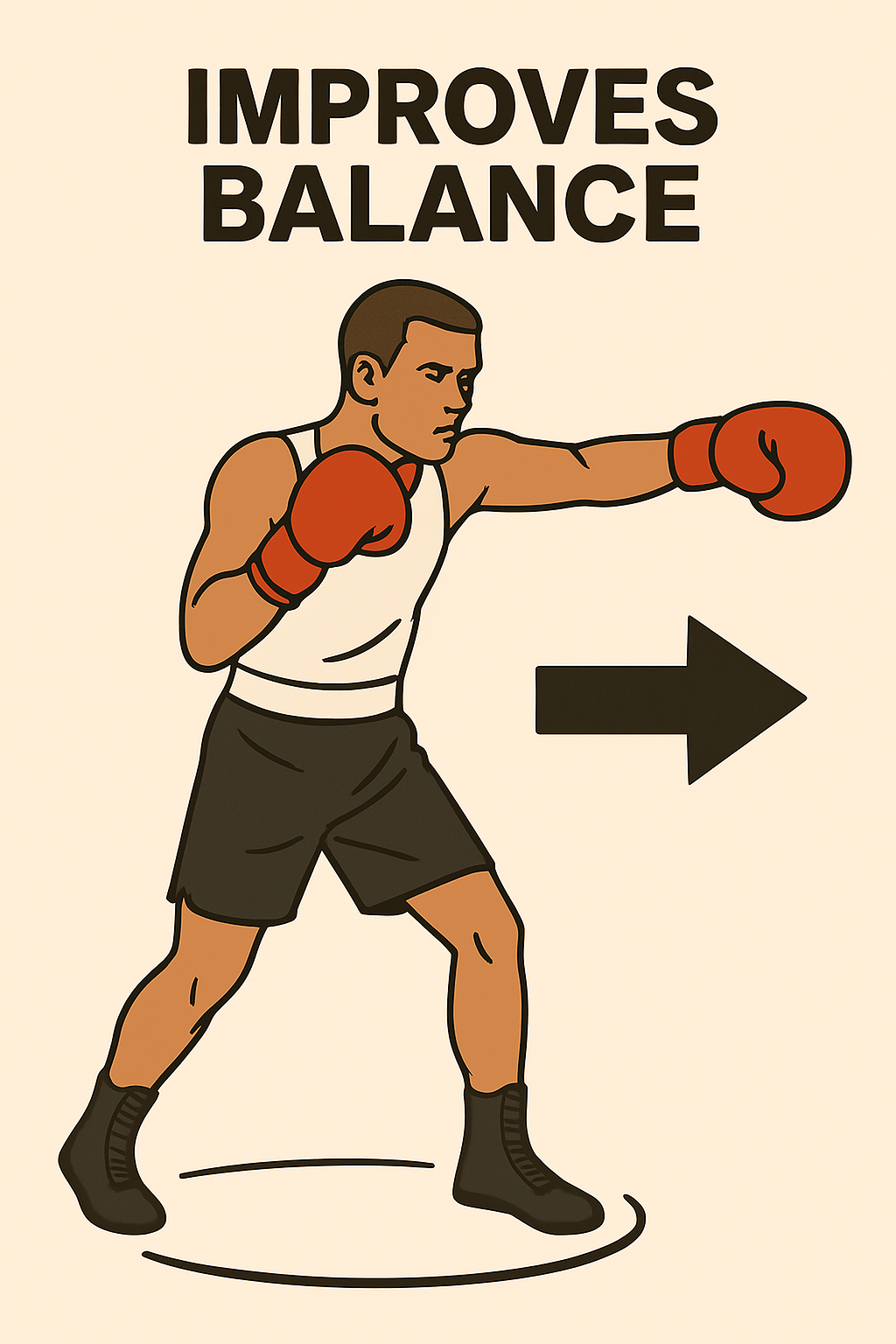
This enhanced balance isn’t just for the ring – it carries over into everyday life. Research has shown that boxing’s balance-building benefits are so practical that they’ve helped stroke patients regain their stability.
You’ll notice improved posture, better spatial awareness, and increased confidence in your movements, whether you’re training or going about your daily routine.
To Wrap It All Up
You’ve now mastered the five essential boxing workouts that’ll elevate your combat capabilities. Like Arnold’s famous “pump,” you’ll notice increased power, sharper reflexes, and enhanced cardiovascular fitness.
Whether you’re looking to build self-defense skills or simply want to get into fighting shape, these workouts will transform you from a beginner to a powerhouse. Remember, every champion started somewhere – now it’s your turn to shine.
FAQs
What Are the Benefits of Boxing Workouts?
Boxing workouts improve cardiovascular fitness, build upper body and core strength, enhance coordination, and increase agility. They reduce stress through high-intensity movements and boost mental focus. Boxing workouts also burn high calories, supporting fat loss and overall physical conditioning.
Is Boxing a Good Workout for Beginners?
Boxing is a good workout for beginners because it improves fitness quickly, teaches basic self-defense skills, and builds confidence. Beginners can modify intensity to match fitness levels. Starting with technique-focused boxing classes ensures safety and proper form development.
Can Boxing Help With Weight Loss?
Boxing helps with weight loss by burning 500-800 calories per hour, increasing metabolism, and building muscle that enhances fat burning. High-intensity boxing workouts create a calorie deficit needed for fat loss while improving overall body composition and fitness.
How Often Should You Do Boxing Workouts?
Do boxing workouts 2-4 times per week to build skill, increase fitness, and support recovery. Beginners can start with two sessions and increase frequency as technique and conditioning improve. Allow rest days between intense sessions to prevent overtraining and injury.
Is Boxing Good Cardio?
Boxing is good cardio because it raises heart rate quickly, improves cardiovascular endurance, and burns high calories through continuous punching, footwork, and combinations. Boxing workouts strengthen the heart, increase lung capacity, and enhance overall aerobic fitness efficiently.
Do You Need Equipment for Boxing Workouts?
You need basic equipment for boxing workouts, such as boxing gloves, hand wraps, and a heavy bag for punching practice. Optional equipment includes focus mitts, jump rope, and resistance bands. Shadow boxing requires no equipment and effectively builds technique and cardio.
Can I Do Boxing Workouts at Home?
You can do boxing workouts at home using shadow boxing, bodyweight conditioning, and footwork drills without equipment. Adding a heavy bag or resistance bands increases workout intensity. Online boxing classes guide home workouts effectively, ensuring proper technique and structured routines.

